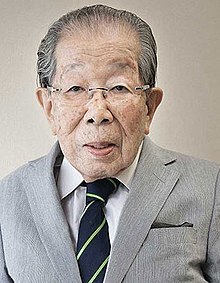| Shigeaki Hinohara | |
|---|---|
 Hinohara in July 2013 Hinohara in July 2013 | |
| Born | (1911-10-04)October 4, 1911 Yamaguchi, Japan |
| Died | July 18, 2017(2017-07-18) (aged 105) Tokyo |
| Other names | 日野原 重明 |
| Occupation | Physician |
You can help expand this article with text translated from the corresponding article in Japanese. (July 2018) Click for important translation instructions.
|
Shigeaki Hinohara (日野原 重明, Hinohara Shigeaki, 4 October 1911 – 18 July 2017) was a Japanese physician. In 1941, he began his long working association with St. Luke's International Hospital in central Tokyo and worked as a medical doctor throughout the wartime firebombing of the city. From 1990 he served as the hospital's honorary director. He was also Sophia University's Grief Care Institute director emeritus. He was honorary chairman of the Foundation Sasakawa Memorial Health Cooperation. Hinohara is credited with establishing and popularizing Japan's practice of annual medical checkups.
Biography
Hinohara was born in Yoshiki District, Yamaguchi Prefecture and graduated from the school of medicine at Kyoto Imperial University in 1937.
During his career Hinohara was known for working during many medical emergencies such as the firebombing of Tokyo during World War II and the Tokyo subway sarin attack. He was also on Japan Airlines Flight 351 when it was hijacked by the Japanese Red Army Faction.
Hinohara became an honorary member of the Japanese Cardiovascular Society and received the Second Prize and the Order of Culture. Kyoto Imperial University, Thomas Jefferson University and McMaster University honored him by conferring on him honorary doctorates.
Hinohara died on 18 July 2017 in Tokyo at the age of 105.
See also
References
- ^ "Yoroku: Dr. Hinohara's lifelong mission was to treat patients". Mainichi Daily News. 19 July 2017. Retrieved 10 July 2018.
- "Shigeaki Hinohara, St. Luke's doctor whose foresight saved lives after Tokyo sarin attack, dies at 105". Japan Times. Kyodo. 18 July 2017. Retrieved 19 July 2017.
- "Shigeaki Hinohara, Japan's centenarian doctor, dies at 105". Mainichi Shimbun. Kyodo. 18 July 2017. Archived from the original on 18 July 2017. Retrieved 19 July 2017.
- "A Week in Asia: Today, Japan; Tomorrow, Singapore - The Hospital Leader - The Official Blog of the Society of Hospital Medicine". thehospitalleader.org. 11 November 2009. Retrieved 10 July 2018.
- "Shigeaki Hinohara: Remarkable life of Japan's centenarian doctor". BBC. 18 July 2017. Retrieved 19 July 2017.
- Lies, Elaine (18 July 2017). "Japan doctor who practiced until months before his death dies at 105". Reuters. Retrieved 19 July 2017.
External links
- About Shigeaki Hinohara United States Ambassador to Japan
- Biography: Shigeaki Hinohara
- Works by or about Shigeaki Hinohara at the Internet Archive
This biographical article related to medicine in Japan is a stub. You can help Misplaced Pages by expanding it. |